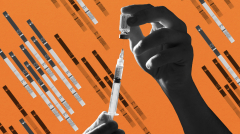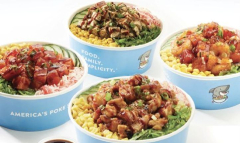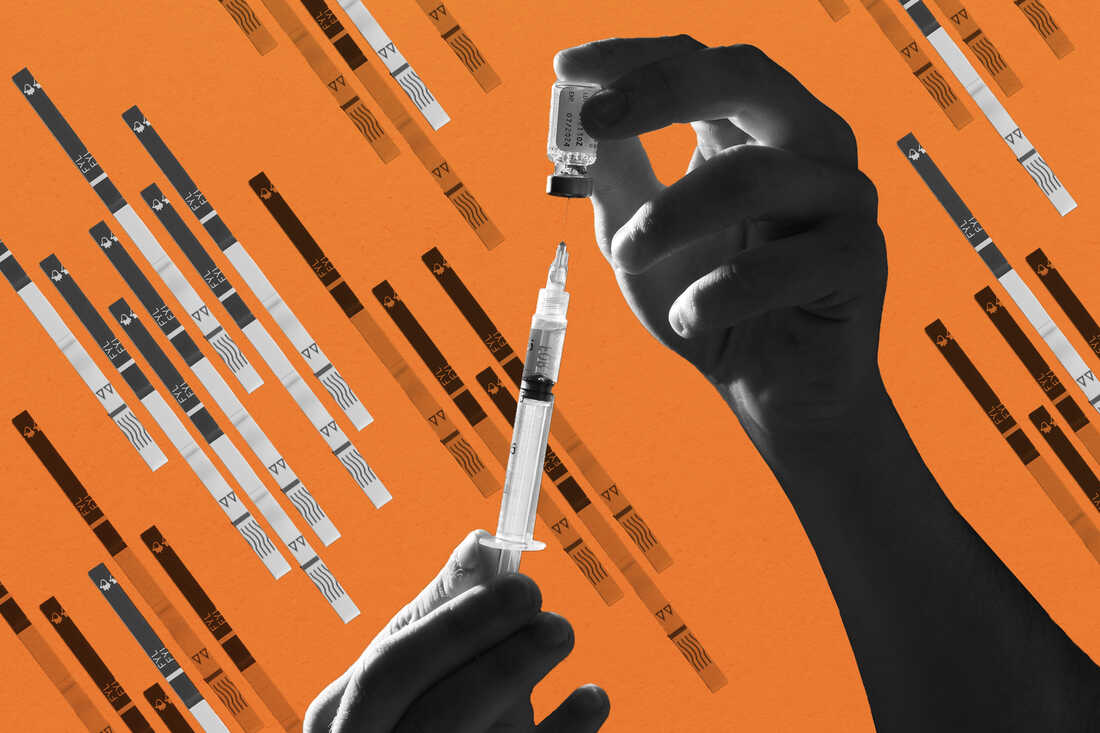
Photo collage by LA Johnson/Cornell Watson/Getty Images/NPR

Photo collage by LA Johnson/Cornell Watson/Getty Images/NPR
At the University of North Carolina at Chapel Hill, three students stand behind a card table covered in naloxone injection kits. When a curious student leans in and asks what the kits are for, Caroline Clodfelter, one of the co-founders of the student group running the table, explains: “It will reverse an opioid overdose. … So let’s say you’re going out to a frat — stick it in your pocket. It’s easy to just have on you.”
Nearly 600 miles away, at the State University of New York’s Delhi campus, Rebecca Harrington, who works in student affairs, has also been tabling to prevent fentanyl overdoses. Her table, though, is full of colorful cups, a water jug and candies in zip-close bags — tools for her demonstration on how to use a fentanyl test strip. These test strips allow students to see whether a pill has been laced with the deadly synthetic opioid.
Test strips and naloxone are becoming more and more common on college campuses, and at least one health department has recommended they be added to school packing lists. For students who didn’t bring their own, many campuses are handing them out at welcome fairs, orientation events or campus health centers.

Fentanyl was involved in the vast majority of teen overdose deaths in 2021, according to the Centers for Disease Control and Prevention. Nearly a quarter of those deaths involved counterfeit pills that weren’t prescribed by a doctor. And the problem has been following teens onto college campuses.
Students may think they’re taking pills like oxycodone, Xanax or Vicodin. Instead, those pills often have fentanyl in them, resulting in overdoses on campuses across the U.S., from Ohio to Colorado to Oregon. At UNC-Chapel Hill, three students died from fentanyl poisoning in just the last two years.
Handing out “an anti-funeral drug” at UNC-Chapel Hill
At one point this fall, UNC senior Riley Sullivan had more vials of naloxone in the closet of his off-campus apartment than even the local hospital keeps in stock.
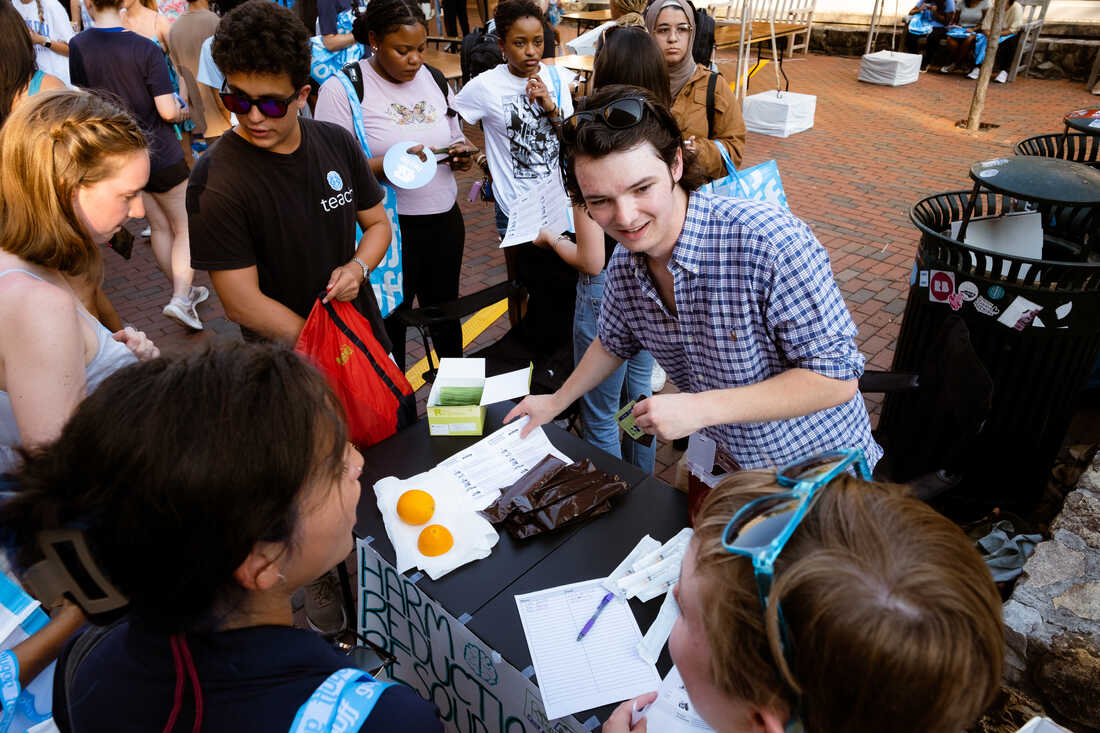
Students Riley Sullivan (center) and Callan Baruch (left) co-founded the Carolina Harm Reduction Union along with Caroline Clodfelter. At a campus event at the University of North Carolina at Chapel Hill this fall, the group handed out naloxone injection kits.
Cornell Watson for WUNC
hide caption
toggle caption
Cornell Watson for WUNC

Students Riley Sullivan (center) and Callan Baruch (left) co-founded the Carolina Harm Reduction Union along with Caroline Clodfelter. At a campus event at the University of North Carolina at Chapel Hill this fall, the group handed out naloxone injection kits.
Cornell Watson for WUNC
Sullivan and Clodfelter are co-founders of the student-led Carolina Harm Reduction Union, the group behind that Chapel Hill tabling event.
He pulls out an orange to demonstrate how to use naloxone on someone who is overdosing, something he has had to do in the past. “You first pop the cap off of your vial,” he says, breaking the sterile seal and pulling out the syringe. “It’s kind of like opening string cheese almost.” He loads the medicine and injects it into the orange. He says to be gentle.
“If you are in the position where you have had to give someone naloxone, they’ve almost died.”

Riley Sullivan injects a dose of naloxone into an orange at his off-campus apartment.
Cornell Watson for WUNC
hide caption
toggle caption
Cornell Watson for WUNC
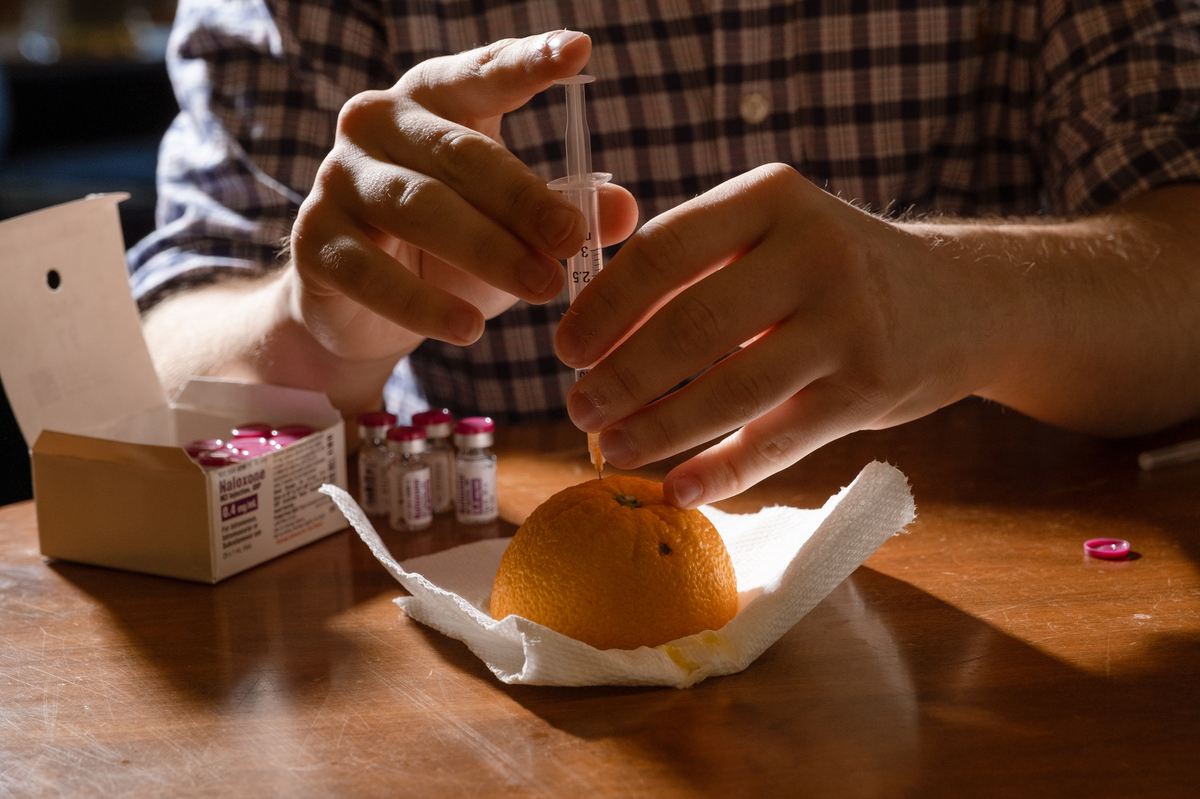
Riley Sullivan injects a dose of naloxone into an orange at his off-campus apartment.
Cornell Watson for WUNC
“Naloxone is what I call an anti-funeral drug,” explains Nabarun Dasgupta, a research scientist at UNC-Chapel Hill’s school of public health. He co-founded the nonprofit, Remedy Alliance/For the People, that supplied all that naloxone in Sullivan’s closet.
“It’s this perfect antidote that really saves people’s lives.”
Dasgupta has been worried about opioid overdoses on campus since 2005, when he was a Ph.D. student at UNC. He remembers telling his professors back then that he wanted to hand out naloxone to students. “They told me point blank that if I did that, I’d get kicked out of school,” he recalls. He did it anyway.
At the time, Dasgupta believes, naloxone was seen as encouraging drug use. But things have changed. Many of today’s college students were born during the opioid crisis and have personal experiences with it. The founders of Sullivan and Clodfelter’s student group each have family and friends whose substance use has ranged from full-on addiction to occasional use at parties.
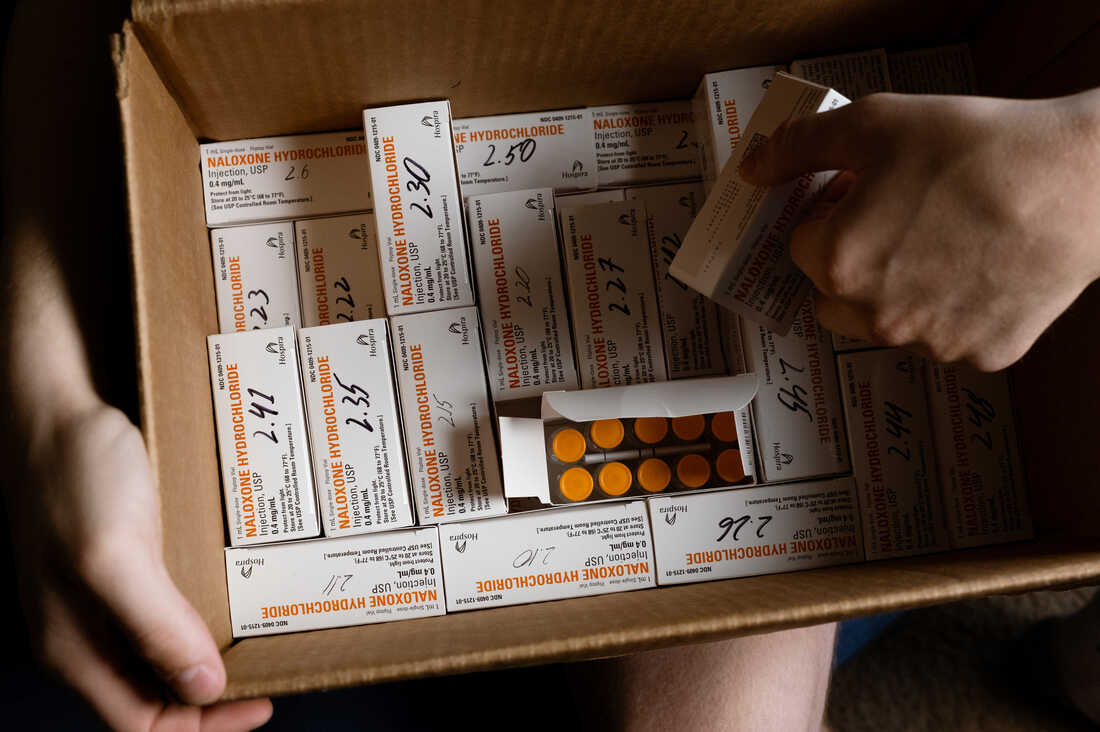
UNC student Riley Sullivan holds a box of naloxone vials that he stores in his apartment for harm-reduction tabling events. Naloxone can reverse an opioid overdose.
Cornell Watson for WUNC
hide caption
toggle caption
Cornell Watson for WUNC
“Even like half a generation ago, we wouldn’t have had that kind of lived experience among undergraduates,” Dasgupta says.
Harrington, at SUNY Delhi, agrees this approach feels very different from the “don’t do drugs” messaging a lot of people are familiar with. But research has found that this messaging alone doesn’t work. Research also shows handing out harm-reduction tools — like test strips and overdose medication — doesn’t lead to more drug use.

Callan Baruch, Caroline Clodfelter and Riley Sullivan each have family and friends whose substance use has ranged from full-on addiction to occasional use at parties. That experience inspired them to form the Carolina Harm Reduction Union.
Cornell Watson for WUNC
hide caption
toggle caption
Cornell Watson for WUNC

Callan Baruch, Caroline Clodfelter and Riley Sullivan each have family and friends whose substance use has ranged from full-on addiction to occasional use at parties. That experience inspired them to form the Carolina Harm Reduction Union.
Cornell Watson for WUNC
“Would it be great to magic-fairy-wand drug addiction away?” Of course, she says.
“But that’s just not the reality of the culture we live in right now.” Instead, she focuses on getting students the tools they need to stay safe.
A lifesaving science experiment at SUNY Delhi
As students approach Harrington’s table on campus, she asks them to crush up a bit of candy — her stand-in for a pill they might have gotten from a friend or through social media. Harrington offers a selection of small items to smash it with — a rock, a bottle, a glass candle jar. Things you m

